Exploring Pour Over Temperature Effects on Coffee
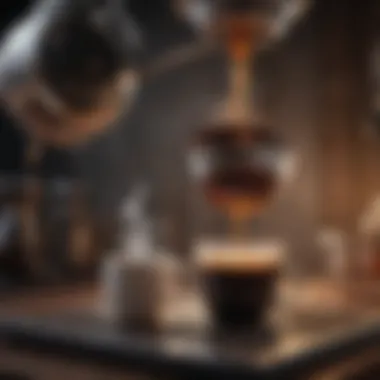
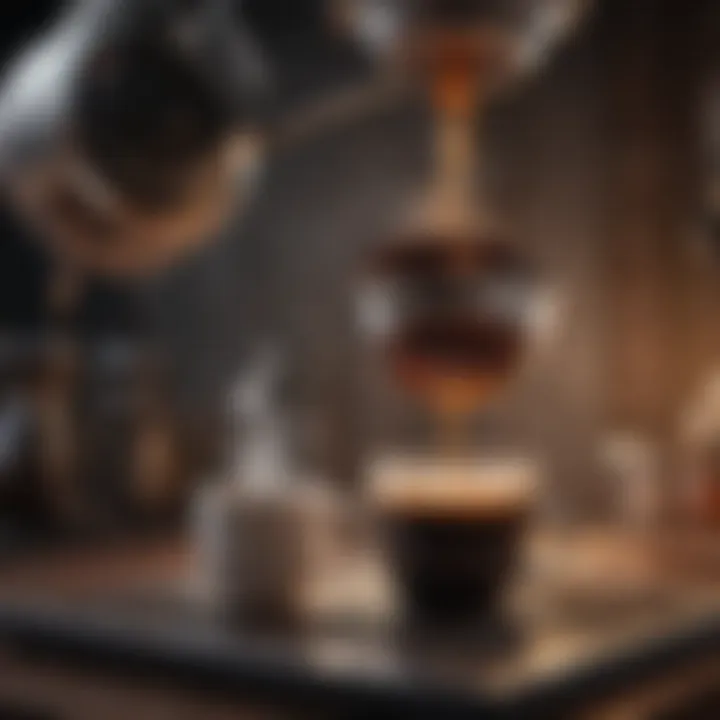
Intro
Brewing coffee is often seen as an art form, where each element contributes to the final masterpiece in a cup. Among these elements, the temperature at which water is poured over coffee grounds stands out as a significant factor influencing the extraction process. The intricacies of this relationship are both profound and fascinating, delving into the realms of physics and chemistry. Understanding how pour over temperature affects coffee extraction can elevate not only the quality of your brew but also your appreciation for this beloved beverage.
Article Overview
Purpose of the Article
This article seeks to dissect the critical role that pour over temperature plays in coffee extraction. By doing so, it aims to provide coffee enthusiasts, aspirants, and professionals with a thorough grasp of how varying temperatures bring out different flavors and aromas in coffee.
The ideal extraction temperature is a topic filled with nuances; too high, and the coffee can turn bitter, while too low can leave it underwhelming and flat. This examination will shed light on these dynamics, paving the way for more intentional brewing practices.
Relevance to Multiple Disciplines
The impact of water temperature on coffee extraction does not merely reside within the sphere of culinary arts. It finds its relevance across various disciplines:
- Chemistry: The science of solubility is central to understanding how different compounds in coffee are extracted.
- Physics: The heat transfer principles underline the methods of brewing coffee and how they influence tasting notes.
- Biology: Understanding how human sensory perception interacts with flavor compounds in coffee adds a layer of complexity to brewing.
By bridging these fields, our discussion provides insights that are applicable not just to coffee aficionados but also to scientists, educators, and researchers exploring sensory experiences.
Research Background
Historical Context
The journey of coffee brewing has evolved over centuries, from the early methods used in Ethiopia to the various brewing techniques we see today. Pour over coffee gained popularity due to its ability to highlight nuanced flavors, and its relationship with extraction dynamics could not be overlooked. As coffee culture burgeoned in the late 20th century, so did exploration into optimal brewing practices, bringing to light the importance of temperature.
Key Concepts and Definitions
To grasp the discussion at hand, we must clarify several key concepts:
- Extraction: The process by which water solubilizes coffee compounds to produce flavors in the brew.
- Ideal Brewing Temperature: The range typically recommended by experts lies between 195°F and 205°F. This range is often cited as optimal for a well-rounded extraction.
- Flavor Profile: The specific taste characteristics that can emerge based on the extraction temperature, affecting the balance of acidity, sweetness, and bitterness.
In the sections that follow, we will delve deeper into these concepts, examining experimental findings while providing practical advice for coffee enthusiasts eager to refine their brewing techniques.
Prologue to Pour Over Coffee
Coffee aficionados and casual drinkers alike have increasingly flocked to pour over brewing methods. This technique is about more than just producing a cup of coffee; it’s an art form that allows for a deep exploration of flavor and aroma. In the context of this article, understanding pour over coffee serves as the foundation for delving into the intricacies of temperature's role in coffee extraction. The delicate balance between heat and the extraction of coffee’s compounds is critical for crafting the perfect cup, making this exploration both significant and practical for those who want to elevate their brewing skills.
Definition of Pour Over Coffee
Pour over coffee is a manual brewing method that involves pouring hot water over coffee grounds, which are held in place by a filter. This method allows the brewer to have control over various variables—water temperature, grind size, and pouring technique—that influence the coffee’s final taste. The beauty of pour over coffee lies in its simplicity and the level of craft it entails. You might hear folks describe it as a way to channel your inner barista, providing a tactile and sensory experience that many automatized brewing systems don’t match. By focusing on the brew process, enthusiasts can engage with flavors that can be nearly lost in faster, less attentive methods.
History and Evolution of Brewing Methods
The journey of coffee brewing is as rich as the beverage itself. The origins of coffee drinking can be traced back to ancient Ethiopia, but the modern brewing methods we know today have evolved significantly over hundreds of years. Pour over methods began gaining traction in Japan during the mid-20th century, with the inception of devices like the Hario V60 and Chemex. These brought a precision and artistry to coffee making that resonated with many.
The evolution didn’t stop there. Cultural shifts and globalization introduced different brewing styles across borders. Espresso machines captured attention in Italy, while French presses offered a straightforward approach. However, the pour over method stood out as it combined technique and control. Today, baristas and home enthusiasts alike turn to pour over techniques to express creativity and craft unique flavors. Arguably, this method has reshaped coffee culture and how we appreciate the beverage, bringing a spotlight on the relationship between brewing variables, notably temperature, and flavor extraction.
Temperature and its Role in Coffee Brewing
Temperature plays a pivotal role in the world of coffee brewing, particularly with the pour over method. When we consider how coffee transforms from bean to beverage, temperature is one of the first variables that comes into play. It can either unlock the rich flavors hidden within the coffee grounds or yield a cup that falls flat, lacking the complexity and depth that many enthusiasts seek. The magic of extraction is not merely a matter of thorough soaking; it depends heavily on how hot the water is.
To grasp the impact of temperature on coffee brewing, we must first appreciate that coffee is a solute of various compounds, each with unique solubility characteristics that are temperature dependent. As water heats up, its capacity to extract oils, acids, and sugars from the coffee grounds increases, leading to more vibrant flavors in the cup. But here lies the catch: too high a temperature can lead to over-extraction—this is the phase where your coffee turns bitter, losing those delightful subtleties that make it enjoyable. Finding the sweet spot thus becomes essential for optimal extraction.
Moreover, different coffee varieties—such as Arabica and Robusta—can react distinctively to temperature changes. Arabica coffee might shine with slightly cooler brewing temperatures, highlighting its fruity and acidic notes. In contrast, Robusta, with its heavier body and earthy flavors, might thrive at slightly hotter temperatures. Consequently, understanding temperature and its role in brewing becomes more than just science; it is about artfully balancing the parameters to achieve a desirable outcome.
Key Considerations:
- Extraction Balance: The correct temperature fosters the right balance of acids and sugars, influencing the overall flavor profile.
- Grind Size Interaction: Finer grounds can enhance extraction, but can also lead to over-extraction at higher temperatures.
- Equipment Influence: Different pour over devices may retain heat differently, affecting the outcome significantly.
Temperature does not work in isolation; it interacts with various factors during brewing. Recognizing its significance allows the home barista or professional to refine their process, catering specifically to the coffee in question. In essence, we're looking at a dance of variables, where temperature takes a leading role.
Understanding Thermal Dynamics
Thermal dynamics relates to how heat is transferred within the brewing process and is fundamental for any coffee enthusiast to comprehend. When you pour hot water over coffee grounds, a variety of thermodynamic reactions are underway. Heat causes the water molecules to penetrate the coffee grounds, dissolving essential oils and releasing aromatic compounds.
This process is far from static. The water’s temperature is not uniform; as it flows through the coffee, it cools down, impacting the extraction rate. For instance, the first contact of water with coffee grounds extracts compounds like acids and aromatic molecules rapidly, while the latter, more complex compounds take longer to dissolve.
Factors to Consider:
- Surface Area: Finely ground coffee increases surface area, allowing for quicker heat transfer.
- Pour Technique: A slow, steady pour ensures better thermal contact between water and grounds, while a fast pour might lead to uneven extraction.
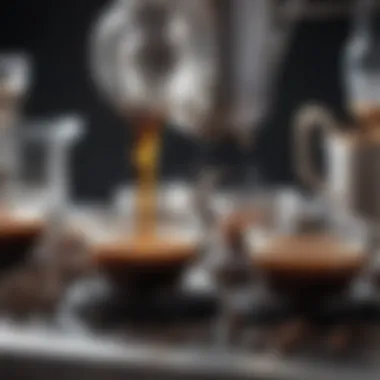
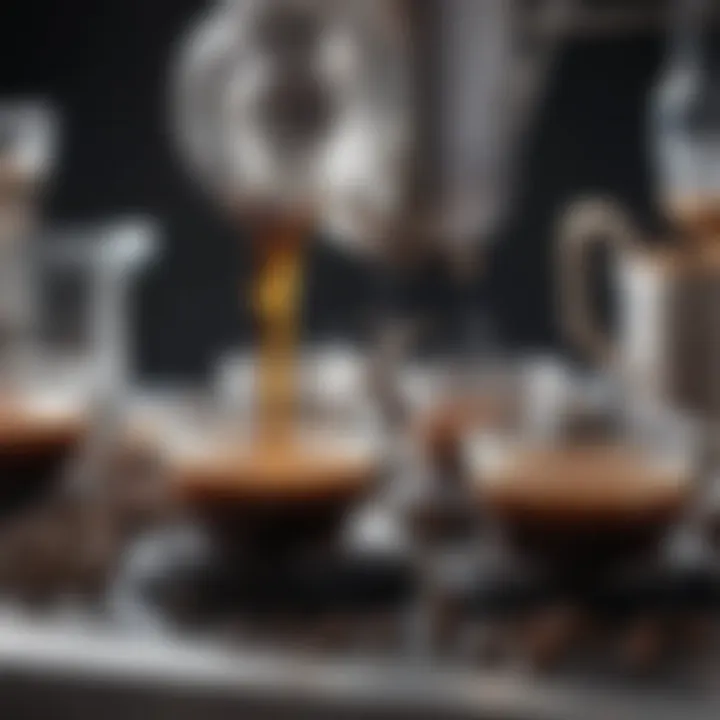
A well-regulated brewing process that factors in thermal dynamics ensures that you’re getting the most out of your coffee. Grasping these concepts not only enhances the brewing experience but also sensitizes you to minor adjustments that can lead to substantial improvements in flavor.
Heat Transfer in Pour Over Techniques
When discussing heat transfer, it's helpful to begin with the concept of conduction, convection, and radiation. These heat transfer modes work together to ensure that your coffee is brewed evenly and at the right temperature.
- Conduction: This is the direct transfer of heat from the hot water to the coffee grounds. The contact point is critical. If your coffee filter or dripper does not allow for good contact, heat transfer is compromised.
- Convection: When hot water moves and circulates through the coffee, it carries heat. This process can greatly enhance the evenness of extraction, allowing for more balanced flavors.
- Radiation: While less prevalent in the pour over method, infrared radiation can still play a minor role in heat exchange.
Understanding these modes of heat transfer can enhance both brewing efficiency and flavor extraction. For instance, baristas often take care to swirl the water gently as they pour, promoting convection and ensuring that each coffee ground receives adequate heat.
"Temperature is not a monolith; it is a nuanced variable influencing the entire brew process."
"Temperature is not a monolith; it is a nuanced variable influencing the entire brew process."
Optimal Pour Over Temperature
The temperature at which coffee is brewed significantly affects its final taste. Understanding this aspect is critical for those dedicated to mastering the art of pour over coffee. Optimal pour over temperature not only influences extraction efficiency but also plays a vital role in the development of flavor profiles. When we discuss optimal temperatures, we touch upon precision and intention in every step of the brewing process. The choice of temperature can nudge a coffee from mediocre to superb, making it essential for enthusiasts, educators, and professionals alike.
Recommended Temperature Ranges
When brewing coffee, the suggested temperature range often falls between 195°F to 205°F (90°C to 96°C). This range is lauded by many experts as ideal for maximizing flavor extraction and minimizing undesirable attributes. Let’s break this down further:
- Lower Range (195°F / 90°C): At this temperature, light roasts gain subtle, delicate flavors, often linked to floral or fruity notes. However, some oils and acids may not fully release, possibly leading to under-extraction.
- Upper Range (205°F / 96°C): Here, a bolder flavor profile emerges, with richer notes from darker roasts coming to the forefront. Higher temperatures can draw out bitterness and more intense body, which some may enjoy, but caution is needed as excess heat can lead to over-extraction, overshadowing the nuances of the coffee.
When we view it through a broader lens, finding the sweet spot may depend on individual taste preferences and the specific type of bean used. Experimentation within this range can strike a chord with the palette of each coffee lover, revealing unique qualities that can often be surprising.
Temperature Influence on Extraction Rates
Temperature does more than just make coffee hot; it actively influences how compounds within the coffee beans dissolve in water. The extraction rate refers to the speed at which flavors, oils, and sugars are pulled from the coffee grounds during brewing. As temperature rises, so does the extraction rate. There are several key points to consider:
- Faster Extraction: Warmer water promotes quicker extraction of soluble compounds. The higher the temperature, the more rapidly these compounds dissolve into the brew. This can be beneficial when aiming for a robust flavor but also poses risks of extracting unwanted compounds that create bitterness.
- Balance is Key: If the temperature is too high, one risks over-extraction, a condition where bitter flavors dominate, masking the subtlety of high-quality coffee. Lower temperatures may yield under-extraction, where desirable flavors remain trapped, leaving the coffee flat.
- Refining Techniques: To control extraction effectively, brewers can adjust other variables such as grind size and brew time. For instance, a coarser grind at a higher temperature may yield a different flavor profile compared to a finer grind, enhancing certain aspects while suppressing others.
Coffee is like a delicate dance between science and art. The temperature acts as a conductor; the beans shaping the melody.
Coffee is like a delicate dance between science and art. The temperature acts as a conductor; the beans shaping the melody.
In sum, understanding the interplay between temperature and extraction rates empowers coffee drinkers to tailor their brews to match their personal taste preferences, making each cup a unique experience. Educators and professionals have a wealth of opportunity to share these insights with their communities, fostering a deeper appreciation for this beloved beverage.
Chemical Composition of Coffee
Understanding the chemical composition of coffee is crucial as it lays the foundation for how temperature influences coffee extraction. The richness and complexity of a good brew stem from various compounds, each contributing to aroma, flavor, and even the health benefits you might enjoy. When brewing coffee, the interplay between temperature and these compounds directly impacts the final cup, making this topic not just relevant but essential for anyone serious about coffee.
Key to grasping this connection is recognizing that coffee is not just a simple mix of water and grounds. Instead, it's made up of more than a thousand different chemical compounds. These include oils, acids, sugars, and proteins, each playing a distinct role during the brewing process. For instance, oils like cafestol and kahweol provide body and flavor intensity, while chlorogenic acids contribute to both the bitterness and antioxidant properties of coffee.
Additionally, understanding how these compounds react at given temperatures allows coffee enthusiasts and professionals alike to refine their brewing techniques. This not only means making a better cup personally but also can lead to advancements in coffee brewing methods.
With that, let’s delve deeper into the critical compounds found in coffee.
Key Compounds in Coffee
When we speak of coffee, several key compounds come into play:
- Caffeine: Perhaps the most well-known component, caffeine acts as a stimulant and significantly affects the sensory experience.
- Chlorogenic Acids: These contribute to the bitter notes in coffee and are sensitive to temperature, influencing taste depending on the extraction level.
- Lipids: Essential for the texture and mouthfeel, lipids also hold aromatic compounds that contribute to overall flavor perception.
- Sugars: Natural sugars in coffee balance acidity and bitterness, significantly altering the cup's flavor profile as they dissolve with heat.
- Amino Acids: These compounds are part of the Maillard reaction during roasting, developing complex flavors when brewed correctly.
When brewed at different temperatures, these compounds behave in unique ways. For instance, higher temperatures can extract more caffeinated profiles and transform the acidity levels, while lower temperatures allow for sweeter, more mellow notes to shine through.
How Temperature Affects Solubility
The relationship between temperature and solubility in coffee is critical to achieving an optimal extraction. As water temperature increases, it enhances the solubility of various compounds. Hotter water extracts more quickly and decisively, pulling bitter compounds like chlorogenic acids to the forefront of your drink. This can lead to a more astringent taste if overshot, resulting in undesirable flavors.
Conversely, lower temperatures might result in an under-extracted brew, lacking depth and complexity. Imagine making coffee with water just shy of boiling—really hot, but not letting it boil away; that’s the sweet spot where coffee starts to shine, without the risk of bitterness tarnishing the experience.
Understanding specific solubility levels helps in calibrating the brewing process. If one aims for a smoother cup, a cooler temperature may allow for a richer extraction of the more delicate tasting notes, enhancing overall balance. This adjustment in temperature not only tailors the coffee profile to individual preferences but also underscores the broader impact of temperature on coffee chemistry.
"To brew the perfect cup, balance is key; use the right temperature to unlock the flavor while avoiding undesirable bitter notes."
"To brew the perfect cup, balance is key; use the right temperature to unlock the flavor while avoiding undesirable bitter notes."
Flavor Profile Variations
Understanding how pour over temperature influences coffee extraction is key for both casual brewers and seasoned baristas. The flavor profile of coffee is often seen as an abstract concept, yet it is deeply tied to tangible variables during the brewing process. Within this context, the temperature at which you brew not only dictates the extraction of soluble compounds but also dictates how these compounds combine to create the flavors you experience.
When you brew coffee, there’s a plethora of volatile and non-volatile compounds in the beans, each contributing its own flavor. The solubility of these compounds varies significantly with temperature. As the water heats up, some of these compounds dissolve more readily, while others may require different temperatures to extract optimally. Hence, precise temperature control is not merely a suggestion; it's vital if one desires to achieve a balanced cup.
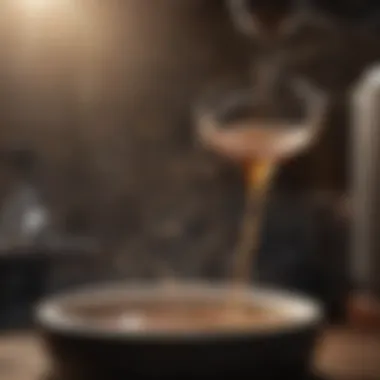
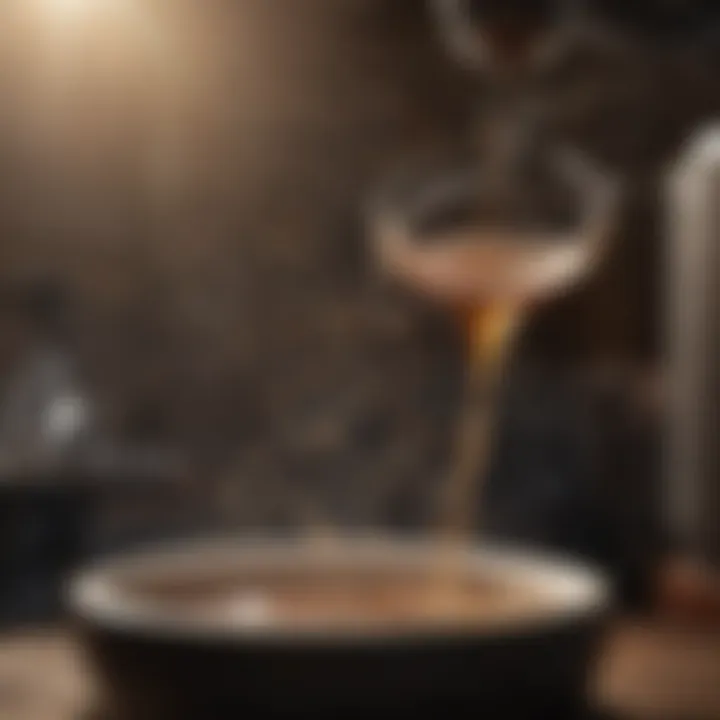
The benefit of understanding these variations is twofold. First, it allows brewers to replicate a desired flavor profile consistently. Second, it opens doors for creativity. With the knowledge of how temperature impacts flavors—be it fruity acidity or savory sweetness—brewers can experiment, modifying temperatures to craft unique cups.
Taste Attributes and Their Chemistry
Taste in coffee can broadly be categorized into several attributes: acidity, sweetness, bitterness, and body. Each of these has a chemical basis that is sensitive to brewing temperature. For instance, acidic flavors, often described as bright, are less pronounced at lower temperatures. They may feel almost hidden, only to emerge prominently as the temperature rises. Similarly, sweetness—a quality tied to sugars—can fluctuate with temperature. When coffee is brewed too hot, it risks pulling out bitter compounds too early and overshadowing the sweetness.
- Acidity: When brewed at higher temperatures, compounds like chlorogenic acids break down into quinic acids, giving that bright tang. If brewed too hot, it can lead to an overly bitter cup that lacks the desirable zing.
- Sweetness: Higher temperatures extract sugars faster, but too hot might drown sweetness into bitterness, giving a muddled experience.
- Bitterness: Hot water can draw out undesirable bitter components early in the extraction cycle, leaving a harsh aftertaste.
Ultimately, understanding the chemistry behind these taste attributes allows coffee enthusiasts to tailor their brews.
Impact of Over and Under Extraction
The line between mastering extraction and falling into the traps of over or under extraction is a fine one. Over extraction happens when the coffee is exposed to hot water for too long or brewed at too high a temperature. This can lead to an excessively bitter, dry, and astringent cup. On the flip side, under extraction doesn't extract enough, leaving coffee flat and lacking in character. With poor extraction, the fabulous nuances can be lost entirely, equating to a less memorable or even unpleasant drinking experience.
Brewing methods significantly influence this aspect. Pour over techniques are particularly susceptible to these extremes as they provide more control over the timing and temperature compared to some other methods.
- Over Extraction Factors:
- Under Extraction Factors:
- High Water Temperature: Brewing above 205°F (96°C) can lead to over extraction.
- Long Brewing Time: Leaving coffee to saturate for too long can pull unwarranted bitterness.
- Low Water Temperature: Brewing below 195°F (90°C) often results in a sour taste, lacking fullness.
- Short Brewing Time: Not allowing sufficient time for water to pass through the coffee can mean many compounds go unextracted.
In the end, achieving the sweet spot in extraction hinges on understanding these dynamics. A systematic approach that involves experimenting with water temperature and brewing time helps reveal a rich canvas of flavors. The goal is to extract a balanced profile that maximizes the best elements of your chosen coffee beans.
Experimental Studies on Pour Over Temperature
Understanding the intricate ways in which temperature influences coffee extraction is a task that requires diligent study and methodical experimentation. Experiments focusing on pour over temperature play a crucial role in illuminating the subtle balances between boiling water and ground coffee. These investigations not only enhance the knowledge base for coffee enthusiasts but also serve practical benefits for both commercial and home brewing.
The significance of these studies lies in their ability to provide quantitative data that delineates how varying temperatures affect extraction, flavor, and overall coffee quality. By conducting experimental trials, researchers unveil the relationship between temperature and solubility of various compounds in coffee, helping to inform best practices and brewing standards. Such studies embark on the journey of translating complex chemical interactions into actionable brewing techniques.
Key Research Findings
Research has pinpointed several significant outcomes related to the temperature during the pour over process. For instance:
- Extraction Rates: Experimental studies have shown that the temperature of the water significantly impacts the rate at which soluble compounds are extracted from the coffee grounds. A higher temperature generally promotes a quicker extraction, leading to a more robust flavor profile.
- Chemical Composition: Different temperature levels demonstrate their own unique chemical profiles in the brewed coffee. For example, brewing at 95°C (203°F) tends to extract the acidic compounds more effectively compared to cooler temperatures that may yield a more balanced flavor.
- Taste Sensation: Sensory evaluations from these studies reveal that coffee brewed at higher temperatures often exhibits more bitter notes, while lower temperatures tend to emphasize acidity and sweetness. This is vital information for those aiming for a specific flavor profile in their cup.
In summary, the findings from various studies reveal that temperature control is not merely an afterthought; it's an essential variable that can make or break the overall quality and experience of the brew.
Methods of Temperature Control
Achieving precise temperature control during the pour over process takes some skill and understanding of different techniques. Here are key methods employed by both amateurs and professionals:
- Digital Kettles: These kettles allow users to set specific temperature targets, providing a high degree of accuracy. Many models come with features to hold the temperature over time, ensuring that the water remains at an ideal level during the brewing process.
- Thermometers: Utilizing standalone thermometers can also be effective. Some baristas prefer to measure the temperature manually to gain insights into thermal dynamics as they brew.
- Pre-heating Equipment: The components you use can greatly influence water temperature. Pre-warming your dripper and cups can help maintain a consistent temperature profile through the brewing process.
- Pouring Technique: The speed and style of pouring can have an impact on how heat dissipates during the extraction. A slow, consistent pour can help maintain the temperature longer than a quick splash approach would.
The knowledge gained from these studies, complemented with practical methods of temperature control, arms both enthusiasts and professionals with the necessary tools to optimize their brewing technique.
"Temperature is the silent architect of coffee flavor, shaping every sip you take."
"Temperature is the silent architect of coffee flavor, shaping every sip you take."
With ongoing research and experimentation, the coffee community continues to refine their understanding of how temperature influences the interaction between water and coffee, ultimately enhancing the enjoyment of this beloved beverage.
Practical Tips for Enthusiasts
For anyone who has ever sipped a perfect cup of pour over coffee, it’s no secret that temperature plays a pivotal role in this experience. The right pour over temperature not only helps extract the best flavors from the coffee grounds but also ensures that you’re brewing at a level where the essence of the beans truly shines through. Practical tips can serve as a roadmap, guiding enthusiasts on how to customize their brew to achieve a balance between aroma, taste, and ultimately, satisfaction.
Adjusting Temperature at Home
One of the simplest yet most effective ways to improve your coffee brewing is to fine-tune the water temperature at home. Here’s how you can go about it:
- Use a Thermometer: An instant-read digital thermometer gives you precise measurements, letting you adjust as necessary. It’s a small investment for a huge improvement.
- Boil, Cool, Brew: After boiling water, let it sit for about 30 seconds before pouring. The general consensus suggests a brewing temperature between 195°F and 205°F. Too hot? The coffee tastes burnt. Too cool? The flavors might be underwhelming.
- Experimentation is Key: Try brewing at different temperatures and take notes. This creates a personal flavor profile that aligns with your taste buds. You might find that a couple degrees difference can lead to remarkably diverse flavors.
"Temperature is like the guitarist in a band. On its own, it may sound a bit off, but harmonized well, it’s pure magic."
"Temperature is like the guitarist in a band. On its own, it may sound a bit off, but harmonized well, it’s pure magic."
Don’t underestimate the power of temperature. A small tweak can turn a lackluster cup into a sensory delight.
Brewing Equipment Considerations
The tools and equipment you choose for pour over brewing can seriously influence the control you have over the temperature. Cater to your setup to maximize potential:
- Choose the Right Kettle: A gooseneck kettle allows for precision pouring, helping you regulate how hot your water is while soaking the grounds evenly. Many are equipped with temperature control settings that let you set and forget.
- Quality Filters: Filters can trap oils and other compounds which can affect not just taste but temperature retention. Going for thicker filters can help maintain warmth longer during brewing.
- Preheat Your Equipment: Rinse filters and preheat your brewing vessel before starting. This helps retain heat through the brewing process and prevents any abrupt temperature drop when you pour the initial water.
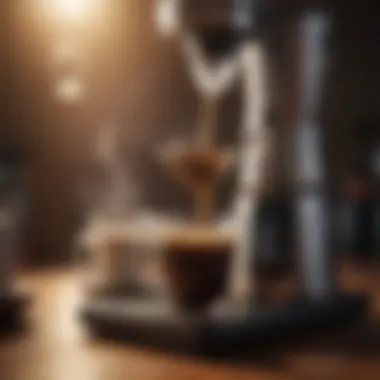
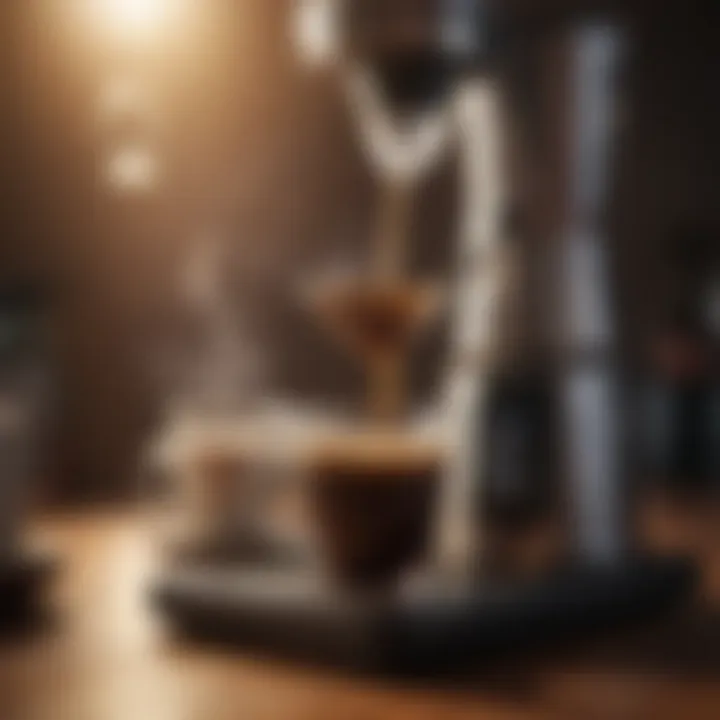
By understanding the nuances of how your brewing setup influences temperature, you equip yourself with the tools to craft a cup of coffee that resonates with your palate and preferences.
Enhancing pour over coffee isn’t merely about the choice of beans; it’s a symphony of science and art, composed from equipment, temperature, and personal touch.
Common Misconceptions
When discussing the role of temperature in pour over coffee extraction, it's paramount to address prevailing myths swirling around this seemingly straightforward process. Oftentimes, misconceptions can cloud our understanding, leading to practices that may not yield the best cup of coffee. Understanding these misunderstandings allows brewers to hone their skills, ensuring they achieve optimal extraction and flavor.
Myths Surrounding Coffee Brewing Temperature
One common myth is that higher temperatures always produce superior coffee. Many enthusiasts believe that boiling water will extract more flavors from the coffee grounds. However, coffee compounds have different solubility rates influenced by temperature. For example, while certain acids might dissolve best at high temperatures, over-extracting can lead to bitterness, overshadowing the desirable flavor attributes of the coffee.
Another prevalent myth is the belief that coffee should be brewed at a fixed temperature. The idea of a one-size-fits-all approach doesn’t hold water when it comes to pour over techniques. Light roasts might benefit from slightly higher temperatures to adequately extract their complex flavors, while darker roasts often require cooler water to avoid bitterness.
Additionally, some think that holding water at a specific temperature during the brewing process is unnecessary. In reality, the temperature can fluctuate during brewing depending on environmental conditions and the pour method used, which can ultimately affect the final taste.
Separating Fact from Fiction
To separate fact from fiction, it's important to consider scientific principles. Research consistently highlights that ideal brewing temperatures generally sit between 195 to 205 degrees Fahrenheit. This range allows for a balanced extraction, where sweet, acidic, and bitter compounds blend harmoniously.
- Over Extraction: High temperatures can lead to unwanted bitter notes, as more undesirable compounds are coaxed into solution.
- Under Extraction: Conversely, cooler temperatures might not suffice for mashing out all the goodness hidden in the beans, leaving you with a watery, lackluster brew.
In essence, context is crucial. Consideration of the coffee type, roast level, and personal preference can lead to a tailored approach that may diverge from the general rule. This customization is both an art and a science, reflecting individual taste rather than adhering to rigid guidelines.
"The right temperature is half the battle; understanding your beans and their unique preferences is the other half."
"The right temperature is half the battle; understanding your beans and their unique preferences is the other half."
In summary, dispelling these myths empowers home brewers and professionals alike, leading to greater appreciation for the nuances of coffee chemistry and its relationship to temperature. Properly understanding how to balance these factors can transform a mediocre cup into a remarkable experience.
Expert Opinions
In the realm of coffee brewing, the insights from seasoned professionals—like baristas and chemists—are integral to understanding the nuances of pour over temperature and its effect on extraction. Their expertise not only sheds light on the complexities of coffee chemistry but also offers practical advice for coffee enthusiasts eager to elevate their skills. By gathering perspectives from these experts, one can grasp the significance of precision in temperature control during the brewing process.
Both baristas and chemists emphasize that temperature is a variable that can radically alter the flavor of coffee. While training in coffee shops often focuses on technique, the underlying science remains critical. Baristas, relying on their day-to-day experience, often articulate how small changes in temperature can lead to notably different flavors in the final cup. This scientific grounding is essential as it bridges the gap between art and science, ensuring that coffee lovers understand the mechanics behind what they taste.
Insights from Baristas and Chemists
Baristas frequently point out that consistency in temperature is key. However, what exactly does this mean in practical terms? Consider this: a pour over made at a temperature too high can extract undesirable bitter compounds, while brewing at too low a temperature may result in a lack of flavor depth.
Moreover, chemists delve into the solubility aspects, noting how different compounds in coffee beans—like oils and acids—respond to varying temperatures. When a barista recommends a specific temperature range, they are not merely offering a guideline; they reflect their engagement with scientific principles exemplified by chemists.
"Temperature isn’t just a number; it’s a pathway to flavor. Each degree counts."
"Temperature isn’t just a number; it’s a pathway to flavor. Each degree counts."
This collaboration between baristas and chemists fosters a deeper comprehension of coffee brewing, enhancing the overall quality of coffee served. Barista training often includes discussions with chemists, adding layers to their knowledge about how to best extract flavors and aromatics.
The Future of Coffee Brewing Practices
Looking ahead, the future of coffee brewing practices is likely to be shaped by continuously advancing technology and a push toward more nuanced brewing techniques. Smart kettles that allow precise temperature control are already infiltrating cafes and homes alike. This technology will undoubtedly lead to a more educated coffee community. As automation and precision meet craftsmanship, we can expect baristas to incorporate science-backed methods to enchant customers with consistently excellent cups of coffee.
Moreover, as sustainability becomes paramount in the coffee industry, innovations in temperature-controlled methods may also promote environmentally friendly practices. By ensuring optimal extraction, resources won't be wasted on over-extraction and subsequent waste due to undesirable flavors.
In sum, the blend of expert knowledge and future technological advancements will pave the way for a more sophisticated coffee culture, elevating the drinking experience while grounding it firmly in science.
Finale
Summarizing Key Insights
In summing up the key insights, it becomes clear that the pour over method thrives significantly on the temperature at which water meets coffee grounds. Careful attention to temperature helps in achieving optimal extraction, which brings the unmistakable flavors forward while minimizing undesirable bitter notes. Here are some takeaways:
- Temperature Range Matters: Most experts recommend a brewing temperature of 195°F to 205°F (90°C to 96°C) for ideal extraction.
- Complex Flavor Profiles: Varied extraction rates contribute to diverse flavor profiles. Under-extraction might yield a sour taste, while over-extraction can lead to bitterness.
- Influence of Ground Size: The grind size of coffee beans also interacts with temperature; finding the right balance is essential.
- Temperature Fluctuations: Even minor fluctuations in water temperature can lead to significant taste variations.
These insights are pivotal not just for brewing enthusiasts but also for coffee shops where consistency is foundational for customer satisfaction.
Future Directions for Research
The future of temperature-controlled extraction research opens a world of possibilities for both the coffee science community and culinary innovators. Potential areas for further exploration include:
- Temperature Profiling: Understanding how different water temperatures affect specific compounds in coffee can guide refinement in extraction techniques.
- Equipment Innovation: Investigating novel brewing devices that allow better temperature regulation could enhance home brewing.
- Sensory Analysis: A deeper look into how varying temperatures impact taste perception, balancing between subjective experiences and empirical measurements.
- Sustainability Practices: Researching energy-efficient methods for maintaining desired water temperatures can help reduce the environmental footprint of coffee brewing, which is crucial in today's eco-conscious climate.
These steps may help in driving the conversation forward, leading to innovations that benefit both producers and consumers.
"The journey of understanding coffee is intertwined with knowledge of its chemistry and physics, paving the path for a better brewing experience for all."
"The journey of understanding coffee is intertwined with knowledge of its chemistry and physics, paving the path for a better brewing experience for all."
By embracing these considerations, it’s clear that the pursuit of the perfect cup can blend science with art in coffee making. As research advances, one can only hope to see a fusion of improved flavors, sustainable practices, and enhanced brewing methodologies.



